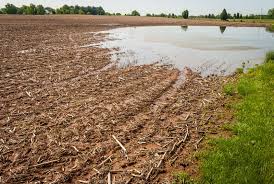ILSOYADVISOR POST
The Surprising Story of Soil Compaction Caused by Water
We’ve all seen water standing in low spots as we’re driving by fields, but why is the water there? Is there nowhere for the water to go, a clogged drainage tile, heavy traffic area, or could it be compaction from all that water? For the purpose of this article, let’s look at how compaction caused by standing water impacts soybean production.
How does water create compaction?
 Porosity, the space between soil particles, can help us answer this question. In normal circumstances, water moves through the space between soil particles and drains away. If water is standing on the surface, the voids between particles in the soil are full and the surface water must wait for space to open up in order to continue draining.
Porosity, the space between soil particles, can help us answer this question. In normal circumstances, water moves through the space between soil particles and drains away. If water is standing on the surface, the voids between particles in the soil are full and the surface water must wait for space to open up in order to continue draining.
As water builds on the surface, more and more pressure is applied to the soil. For each foot of water, 2.31 pounds per square inch is applied to the soil particles, and over time this can start to cause those void spaces to collapse. That collapse in void space is compaction. When there are fewer or smaller void spaces, more water can pool, and it will stay on the surface longer and longer each time.
What does this have to do with soybean production?
Soybeans need the same as most other plants to survive. Sunlight, oxygen, water, carbon dioxide, nutrients, etc. When soil is compacted, things like water, oxygen and nutrient uptake can be limited.
Another issue is seeding depth. If the planter is set for a field that is not compacted, it is more likely to lift and not be able to penetrate to the ideal seeding depth as it hits a compacted area. Shallow planting has multiple side effects including losing moisture (sun drying out soil too quickly), standability issues later in season and even yield loss.
So how do I fix this problem?
Rebuilding soil structure isn’t accomplished overnight. The first step is to fix the underlying issue by figuring out how to get rid of the water. Adding drainage tile to the area and maybe a water way or other surface drainage engineering is needed. Next, start thinking about how to open the void spaces in the soil structure. Adding cover crops, adopting conservation tillage, or minimizing traffic over the area could also help.
When it comes to soil compaction, most think the first culprit is equipment. In some cases, water may be the bigger issue. Ponded areas cause more than stand loss, increased disease pressure and decreased yield. They also cause soil compaction that can gradually get worse over time. The economic benefits over time of improving soil structure outweigh the costs.





Comments
Add new comment